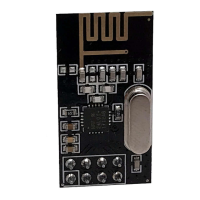These transceivers use the 2.4 GHz unlicensed band like many WiFi routers, BlueTooth,
some cordless phones etc. The range is 2.400 to 2.525 Ghz which is 2400 to 2525 MHz
(MegaHz). The nRF24L01 channel spacing is 1 Mhz which gives 125 possible channels
numbered 0 .. 124. WiFi uses most of the lower channels and we suggest using the
highest 25 channels for nRF24L01 projects.
Transceivers like these both send and receive data in 'packets' of several bytes at a time.
There is built-in error correction and resending, and it is possible to have one unit
communicate with up to 6 other similar units at the same time. The RF24 Network Library
extends this to multiple 'layers' of interconnected transceivers.
These amazing low-cost units have a lot of internal complexity but some talented people
have written Arduino libraries that make them easy to us. They all use the same pinout as
shown in the following diagram, which is a TOP VIEW (Correction!):
Here are details of the Pinout and connections to Arduino (updated):
Signal RF
Module
PIN
Cable
COLOR
Base
Module
PIN
Arduino
pin for
TMRh20
RF24
Library
Arduino
pin for
RF24
Library
Arduino
pin for
Mirf
Library
MEGA2560
pin
RF24
Library
Arduino
Pin for
RH_NRF2
4
RadioHead
Library
MEGA2560
Pin for
RH_NRF24
RadioHead
Library
GND 1 Brown GND GND GND * GND GND * GND * GND *
VCC 2 Red VCC 3.3 V 3.3V * 3.3V 3.3V * 3.3V * 3.3V *
CE 3 Orange CE 7 9 8 9 8 8
CSN 4 Yellow CSN 8 10 7 53 10 53
SCK 5 Green SCK 13 13 13 52 13 52
MOSI 6 Blue MO 11 11 11 51 11 51
MISO 7 Violet MI 12 12 12 50 12 50
IRQ 8 Gray IRQ - 2 per library N/C N/C
NOTE!! Most * problems with intermittent operation are because of insufficient current or
electrical noise on the 3.3V Power supply. The MEGA is more of a problem with this.

